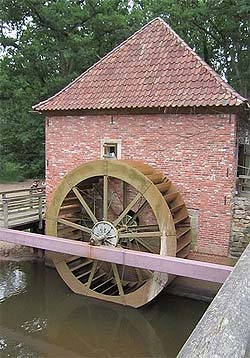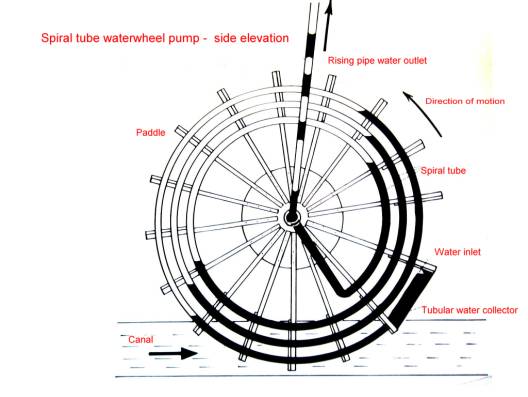The water wheel
 The water wheel is an interesting invention. It has always fascinated me in its simplicity and elegance, and it is used on a stream, which involves the soothing sound of water.
The water wheel is an interesting invention. It has always fascinated me in its simplicity and elegance, and it is used on a stream, which involves the soothing sound of water.
It has been around for more than 2000 years, commonly used to power mills. During the industrial revolution it eventually got replaced by the turbine, which is more efficient.
There are three types of water wheels: The undershot, where water enters under the center of the wheel, as illustrated to the right, the overshot, where water enters above the wheel, and the vertical axis, where the water flows straight down onto a wheel that looks more like a propeller.
The material used is commonly wood, but wheels out of steel can also be found.
How much energy can be harvested from a water wheel? I asked myself this question when I had my farm, and was thinking about building one to generate electricity for the house. The height of the supporting canal was 3 m higher than the pond that it fed, and there was around 2 cubic meters of water passing per minute, so it looked promising.
If half of that water could pass over the water wheel, at a 2 meter drop, then it is the equivalent of P = 1,000 kg x 2 m x 9.81 / 60 seconds = 327 W of power. I checked my electric bill and saw that I used on average 100 units (100 kWh) per month, which is equivalent to an average of 139 W around the clock. In other words, I would have to run that wheel 50% of the time to cover my energy use, and of course use batteries to cover for uneven use.
Pumped-storage hydroelectricity
The problem with batteries is that they have a very limited life span of around 5 years, and they are expensive to buy. A way to solve this is to dig a very large dam that acts like an accumulator, so water can run at constant flow over the wheel. However, this dam needs to be really large for it to matter. If you want an accumulator that can hold a week's use of water, it needs to be V = 2 m3 x 60 minutes x 24 hours x 14 days = 40,000 m3. That is a soccer field that is dug 3 meters deep.
Of course, the higher the fall of the water, the more energy it contains, and the less volume is needed. If you are lucky to live high up in the mountains at a location where you can dig a reasonably large dam, and put an efficient turbine 20 meters below, then you could cut the volume to 2,000 m3, which is an area of about 30 x 30 meters, 2 meters deep. It could be lined with cement and also used as a fish farm.
The beauty of such a system is that it could be used together with solar power. Create a dam of equal size at the exit of the turbine to hold the used water. Then let an array of solar panels power a pump that pushes the water back to the upper dam in the daytime. This is a system that virtually never wears out, and all it needs is some rain to replenish the levels in the dams every now and then. It would be very exciting to try it out some day.
The spiral pump
If you add a tube in a spiral configuration to the water wheel, you get a pump that can push the water to a height that is several times the size of the wheel. It's an ingenious idea. As with the hydraulic ram, it uses the flow energy of water to pump up a lesser volume of water to a higher elevation.

As you can see in the drawing above, the water flows to the right and turns the wheel anti-clockwise. Once every revolution the collector fills up with water, which flows into the tube. About half of the tube will be filled with water and the rest with compressed air, as the collected water pushes the air by its weight. At the hub of the wheel is a rotational lock with a gasket that lets the water out of the spiral, and rise up to the outlet point. The water will come out in bursts, mixed with air. In a practical test, a 2 m spiral pump was able to pump water up to 8 m using six loops of tubing.
